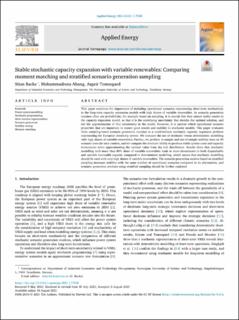| dc.contributor.author | Backe, Stian | |
| dc.contributor.author | Ahang, Mohammadreza | |
| dc.contributor.author | Tomasgard, Asgeir | |
| dc.date.accessioned | 2021-08-30T08:58:53Z | |
| dc.date.available | 2021-08-30T08:58:53Z | |
| dc.date.created | 2021-08-24T14:29:51Z | |
| dc.date.issued | 2021 | |
| dc.identifier.citation | Applied Energy, 2021, 302, . | en_US |
| dc.identifier.issn | 0306-2619 | |
| dc.identifier.uri | https://hdl.handle.net/11250/2771704 | |
| dc.description.abstract | This paper examines the importance of including operational scenarios representing short-term stochasticity in the long-term capacity expansion models with high shares of variable renewables. As scenario generation routines often are probabilistic, for example based on sampling, it is crucial that they ensure stable results in the capacity expansion model, so that it is the underlying uncertainty that decides the optimal solution, and not the approximation of that uncertainty in the model. However, it is unclear which operational scenario properties that are important to ensure good results and stability in stochastic models. This paper evaluates three sampling-based scenario generation routines in a multi-horizon stochastic capacity expansion problem representing the European electricity system. We compare the use of stochastic versus deterministic modelling with high shares of variable renewables. Further, we perform in-sample and out-of-sample stability tests on 90 scenario trees for each routine, and we compare the routines’ ability to produce stable system costs and capacity investments when approximating the optimal value from the real distribution. Results show that stochastic modelling with more than 80% share of variable renewables leads to more investments in both dispatchable and variable renewable capacity compared to deterministic modelling, which means that stochastic modelling should be used with very high shares of variable renewables. The scenario generation routine based on stratified sampling increases stability with the same number of operational scenarios compared to its alternatives, and scenario generation routines using stratified sampling should be further explored. | en_US |
| dc.language.iso | eng | en_US |
| dc.publisher | Elsevier Ltd. | en_US |
| dc.relation.uri | https://doi.org/10.1016/j.apenergy.2021.117538 | |
| dc.rights | Navngivelse 4.0 Internasjonal | * |
| dc.rights.uri | http://creativecommons.org/licenses/by/4.0/deed.no | * |
| dc.title | Stable stochastic capacity expansion with variable renewables: Comparing moment matching and stratified scenario generation sampling | en_US |
| dc.type | Peer reviewed | en_US |
| dc.type | Journal article | en_US |
| dc.description.version | publishedVersion | en_US |
| dc.source.volume | 302 | en_US |
| dc.source.journal | Applied Energy | en_US |
| dc.identifier.doi | 10.1016/j.apenergy.2021.117538 | |
| dc.identifier.cristin | 1928371 | |
| dc.relation.project | Norges forskningsråd: 257660 | en_US |
| dc.relation.project | EC/H2020/824260 | en_US |
| dc.relation.project | Norges forskningsråd: 268097 | en_US |
| dc.description.localcode | This is an open access article distributed under the terms of the Creative Commons CC-BY license, which permits unrestricted use, distribution, and reproduction in any medium, provided the original work is properly cited. | en_US |
| dc.source.articlenumber | 117538 | en_US |
| cristin.ispublished | true | |
| cristin.fulltext | original | |
| cristin.qualitycode | 1 | |

